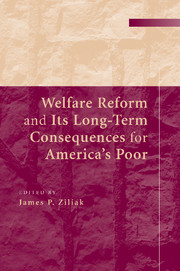Book contents
- Frontmatter
- Contents
- Contributors
- Preface
- Introduction
- 1 What We Know, What We Don't Know, and What We Need to Know about Welfare Reform
- 2 Welfare Reform and the Level and Composition of Income
- 3 How Have Expansions in the Earned Income Tax Credit Affected Family Expenditures?
- 4 How Families Are Doing Nine Years after Welfare Reform: 2005 Evidence from the Three-City Study
- 5 The Impact of Welfare Reform on Leaver Characteristics, Employment, and Recidivism
- 6 A Reexamination of the Impact of Welfare Reform on Health Insurance Among Less-Skilled Women
- 7 How Welfare Policies Affect Child and Adolescent School Performance: Investigating Pathways of Influence with Experimental Data
- 8 The Effects of Welfare and Child Support Policies on the Incidence of Marriage Following a Nonmarital Birth
- 9 Welfare Reform and Health among the Children of Immigrants
- 10 Mismatches and Unmet Need: Access to Social Services in Urban and Rural America
- Index
4 - How Families Are Doing Nine Years after Welfare Reform: 2005 Evidence from the Three-City Study
Published online by Cambridge University Press: 21 January 2010
- Frontmatter
- Contents
- Contributors
- Preface
- Introduction
- 1 What We Know, What We Don't Know, and What We Need to Know about Welfare Reform
- 2 Welfare Reform and the Level and Composition of Income
- 3 How Have Expansions in the Earned Income Tax Credit Affected Family Expenditures?
- 4 How Families Are Doing Nine Years after Welfare Reform: 2005 Evidence from the Three-City Study
- 5 The Impact of Welfare Reform on Leaver Characteristics, Employment, and Recidivism
- 6 A Reexamination of the Impact of Welfare Reform on Health Insurance Among Less-Skilled Women
- 7 How Welfare Policies Affect Child and Adolescent School Performance: Investigating Pathways of Influence with Experimental Data
- 8 The Effects of Welfare and Child Support Policies on the Incidence of Marriage Following a Nonmarital Birth
- 9 Welfare Reform and Health among the Children of Immigrants
- 10 Mismatches and Unmet Need: Access to Social Services in Urban and Rural America
- Index
Summary
Introduction
Much of what we understand about economic outcomes associated with welfare reform comes from studies of families who were initially on welfare and who left after welfare reform (“leaver” studies), from studies of lowincome families in the first few years after reform, and from randomized trial evaluations conducted at around the time of the reform. Blank (2002) reviewed numerous studies that indicated that employment and labor supply for disadvantaged families increased in the immediate aftermath of welfare reform. She also reported that the evidence regarding impacts on incomes and well-being was generally positive, although the leaver studies showed smaller gains. More recently, Grogger and Karoly (2005) and Blank (Chapter One, this volume) summarized evidence from experimental and observational studies that indicated that specific types of reforms, especially mandatory work activities, and welfare reform as a whole contributed to higher levels of employment, larger incomes, and less poverty among welfare households. However, as Moffitt (2002) has pointed out, the rise in incomes in the experimental studies was largely confined to studies without time limits; in the experiments with such limits, which most closely reflectactual welfare reform in the states, the rise in income was insignificant (Bloom and Michalopoulos 2001).
Further, the income gains shown in observational cross-sectional datasets like the Current Population Survey (CPS) or the National Survey of America's Families were almost all a result of increases in income among families not on welfare; incomes for leavers per se rose very little (see the reviews by Blank and by Grogger and Karoly on this point as well).
- Type
- Chapter
- Information
- Welfare Reform and its Long-Term Consequences for America's Poor , pp. 140 - 171Publisher: Cambridge University PressPrint publication year: 2009
- 4
- Cited by

